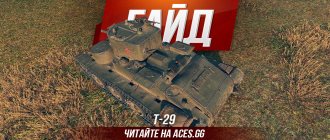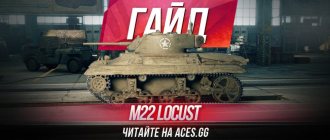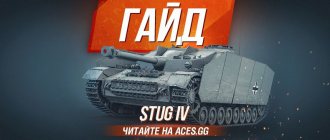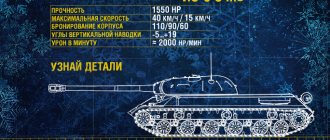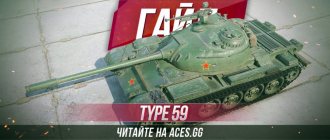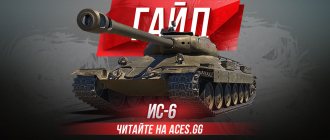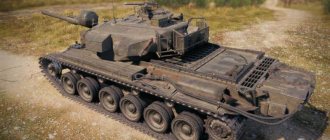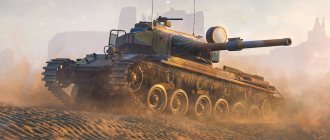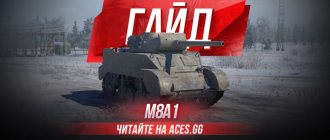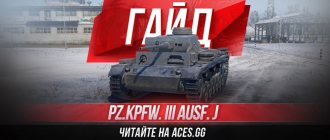Family of machines "LVT"
Landing Vehiche Tracked
The world's first family of specialized landing tracked amphibious vehicles. Developed since 1935 under the leadership of engineer Donald Roebling. Serial production has been carried out since the summer of 1941 by Ford Machinery Corporation. By the end of 1945, 18,621 combat vehicles were produced.
SERIAL MODIFICATIONS: LVT-1 Alligator – steel displacement unarmored trough-shaped hull. Movement afloat is due to rewinding of tracks. The engine and transmission, borrowed from the MZ light tank, are located at the rear. Combat weight 9.897 tons. Armament: 12.7 and 7.62 mm machine guns. Crew 3 people, landing capacity 20 people. 1225 units produced.
LVT-2 Water Buffalo - oversized body, rear engine, front transmission. Improved suspension. 2962 units produced.
LVT(A)-2 – armored version of the LVT-2. 450 units produced.
LVT-3 is a new hull with a folding ramp in the stern. Two Cadillac V-8 engines located on the sides of the vehicle and the transmission were borrowed from the M5 light tank. 2964 units produced.
LVT-4 – LVT-2 with an extended body. The engine is located behind the control compartment, in the stern there is a folding ramp. Some of the vehicles had an armored cabin. 8351 units produced.
LVT(A)-1 – armored version of the LVT-2 with the turret of an MZ light tank with standard weapons. Two Browning M1919A4 machine guns behind shields in the rear of the hull. Combat weight 13.62 tons. Crew 5 people. 510 units produced.
LVT(A)-4 – LVT(A)-1 with a turret from the M8 self-propelled 75-mm howitzer. Enlarged turret box. Large-caliber anti-aircraft machine gun. Later production vehicles had two anti-aircraft guns and an M1919A4 machine gun. Combat weight 17,915t. Crew: 6 people. 1890 units produced.
LVT(A)-5 is an improved version of LVT(A)-4. The number of surveillance devices has been increased. 75 mm howitzer with a vertical guidance stabilizer. 269 units produced.
The first amphibious tractor battalion (1st Amphibious Tractor Battalion) was formed as part of the 1st Marine Division in February 1942. The amphibians' baptism of fire was the assault on the island of Guadalcanal in August 1942. LVT-1s were the only means of delivering personnel and cargo through coral reefs to the shore. In November 1942, US Marine Corps amphibians supported the landing of American troops in North Africa. The most high-profile operation of 1943 involving combat amphibians was the assault on Tarawa Atoll. It was attended by 125 LVT-1 and LVT-2 of the 2nd Amphibious Tractor Battalion. Only a third of them survived by the end of the operation.
Amphibians were used extensively by the Marines in all amphibious operations in the Pacific until June 1945. In the European Theater of Operations, amphibians were used in amphibious operations on a much smaller scale. The landings in Normandy involved mainly vehicles handed over to the British. American troops used their landing tractors mainly when crossing large rivers. Amphibians remained in service after the Second World War. They took part in the war in Korea and French Indochina.
TACTICAL AND TECHNICAL CHARACTERISTICS OF THE LANDING
COMBAT WEIGHT, t: 13,721. CREW, people: 3+24. OVERALL DIMENSIONS, mm: length – 7970, width – 3251, height – 2640, ground clearance – 457. ARMAMENT: 1 Browning М2НВ machine gun 12.7 mm caliber, 1 Browning M1919A4 machine gun 7.62 mm caliber. ENGINE: Continental W670-9A, 7-cylinder, star-shaped, carburetor, air-cooled; power 250 hp (184 kW) at 2400 rpm. TRANSMISSION: five-speed synchronized gearbox, differential. CHASSIS: 11 road wheels on board, two support rollers, rear drive wheel (lantern engagement); each caterpillar has 73 tracks with a width of 362 mm, track pitch is 105 mm. MAX. SPEED, km/h: 32, afloat – 12. COURSE RESERVE, km: 482, afloat – 321. OBSTACLES OVERCOME: angle of elevation, degrees. – 30, wall height, m – 0.9, ditch width, m – 1.5.12
Another Lend-Lease. LVT-4. Buffalo, son of the Alligator
Our hero today is the LVT-4 (Landing Vehicle Tracked) amphibious transporter, better known in military circles as the Water Buffalo. The car is very interesting, but quite rare in the USSR. Accordingly, in our museums too. Simply because of the rather small volumes of supplies. The reason for this situation is discussed below.
Those who happen to see the exhibitions of foreign museums, preferably American ones, will be surprised by another name for this car - “Amtrak”. The name, according to American tradition, as we have repeatedly pointed out, comes from the combination of two words. Amphibious (floating) tractor. Am plus Track (eng. tractor).
Attentive readers have already noticed that the presented car was produced in series. If there is a 4th option, then there were at least the previous 3. This is true. And a story about the 4th LVT is impossible without a story, albeit superficial, about the first cars of this series.
In general, amphibious vehicles are vital for the US Army. The structure of the Armed Forces itself is created in such a way that the Navy has a fairly large weight in it. The Marine Corps is the priority type of troops for Americans. And the Marine Corps is generally independent, like our Airborne Forces, and has a lot of things in its composition.
It was by order of the US Navy that already in the mid-30s, engineer D. Roebling created the first military floating transporters. This same model was developed in 1938-41. And in 1941 it was put into mass production. So - LVT-1.
The first model of the “Roebling amphibious tank”, namely such a banner, judging by the photo, was located on board the first production vehicle - “ROEBLING AMPHIBIAN TANK”, released in the summer of 1941. And it was immediately accepted by the military with a bang.
The initial contract for the production of LVT-1 provided for the production of only 200 vehicles. But, just a few days after the start of the series, the contract was increased to 1225 cars. And the “tank” itself received the bloodthirsty nickname “Alligator”.
540 transporters were received by the Marine Corps, 485 were transferred to the US Army. The remaining vehicles were sent to the Allied armies for inspection.
Did you notice the authors’ “jumps” in the title – “tank transporter”? It would seem that it would be easier to stick to the name that the author gave to his brainchild. We try to give an objective picture of the car. And there from “tank” there is only the letter “T”, and even then in the incorrect decoding of the abbreviation.
The official English name is Landing Vehicle Tracked. And there was the Alligator, an unarmored floating tracked transporter.
The machine had a trough-shaped body, the width of which was equal to almost half the length. The building was divided into three sections. Can you imagine this classic “trough”? You can argue about the car endlessly. but try to argue on the carrying capacity. Especially afloat.
The control compartment had the appearance of a wheelhouse, shifted forward as much as possible, rising above the water and equipped with a roof. It housed the vehicle commander, driver and assistant driver. There were three viewing windows in the front deck of the cabin.
There was another window (hatch) in the vertical sides, which generally gave the crew a good view. On the cars of the first series, the front windows were spaced apart; later they were made closer to each other.
Directly behind the control compartment there was an open-top troop compartment (also a cargo compartment), which could accommodate 20 soldiers in full equipment or about 2 tons of cargo.
In the aft part there was a closed engine-transmission compartment, where a 6-cylinder Hercules WXLC-3 carburetor engine with a power of 146 hp was installed. On the sides of the engine there were fuel tanks with a total capacity of 303 liters, which provided a range of up to 121 km on land or up to 80.5 km on water.
Hollow welded pontoons were attached to the sides of the hull, increasing the buoyancy and stability of the vehicle. Each pontoon was internally divided into five sections, and when one of them was broken through, the vehicle retained its buoyancy reserve and stability. The pontoons served as a frame for mounting parts and assemblies of the chassis.
The drive wheel was mounted on the hull near the stern, and the guide wheel was mounted in the upper front corner of the pontoon. The guide wheel mounting unit had a hydraulic mechanism for adjusting the track tension.
The width of the track track is 260 mm. High stamped lugs were attached obliquely to the tracks, which served as paddle blades afloat. Turning, both afloat and on land, was carried out by braking the caterpillar on one side.
The welded hull was assembled from sheets of soft (non-armored) steel of different thicknesses, since the LVT-1 was not considered as a combat (“assault”) vehicle for amphibious assault, but only as a transporter, allowing soldiers or cargo to be quickly delivered from the ship directly to the shore.
To suppress possible enemy fire and self-defense from close attack, they decided to arm the vehicle with one 12.7 mm M2NV machine gun and one 7.62 mm M1919, or two M1919 machine guns. By the way, when installing the machine guns, a rail guide already known to our readers was used. Why, exactly, reinvent the wheel?
In some vehicles you can see other weapons. Sometimes this is the “technical creativity” of local gunsmiths, but more often it is the factory execution of requests from specific units or even specific units.
We paid so much attention to the Alligator because, despite the rather small production of these machines, they revealed some of the shortcomings and problems of engineer Roebling’s solutions.
First of all, a traditional disadvantage for that time was the engine. In the modes in which the Alligator had to operate, the engine quite often simply collapsed. Durability left much to be desired, as they say.
But the biggest problem was the tracks. The abandonment of water propulsion in favor of caterpillars, along with positive aspects, also has a number of significant disadvantages.
First of all, the heterogeneity of the environment of use and its aggressiveness in almost all aspects. Sea water corrodes metal no worse than acid. This especially applies to hinges.
Then - exit to the sand. There's no need to even comment here. Here blades were added to the hinges. In short, the option of swimming using caterpillars is quite difficult to implement.
Even ordinary soil is deadly for “floating” caterpillars. And for repairmen it’s a constant headache with replacing them with new ones.
The shortcomings that we noticed were also noticed by the designers. Therefore, by December the new car was basically ready. The Japanese, with their attack on Pearl Harbor, accelerated the adoption of the Water Buffalo - LVT-2. The American soldiers called the car a buffalo.
The transporter was significantly different from the Alligator. In fact, the LVT-2 is a completely different machine.
The hull had more “marine” contours. This not only improved the seaworthiness of the transporter, but also, no matter how strange it may sound, made it much easier for the vehicle to get ashore.
The control compartment was moved back, the car received an elongated “nose” with a greater slope of the sheets. The body was welded from steel sheets, a lattice frame was welded inside on the bottom, and the main units were mounted on it. The bow was reinforced with a tubular beam with brackets for cables.
The vehicle turned out to be longer and wider than the previous one, the control room was lower, had two large inspection hatches in the front plate with plexiglass windows folding forward (so that the hatches could be used as manholes in a critical situation) and small inspection hatches in the cheekbones.
But most importantly, the car received the chassis and engine of the tank!
The LVT-2 was equipped with the engine and transmission of the MZA1 Stuart light tank. In the engine compartment, separated from the landing partition by a partition, a star-shaped radial carburetor four-stroke Continental W-670-9 air-cooled engine was mounted. 250 hp at 2400 rpm.
The chassis received an individual suspension with rubber elastic elements, called Torsilastic. All 11 road wheels were suspended from the side pontoons of the hull on swinging arms, while the 1st and 11th rollers were raised above the ground, taking the load when leaving the water on the shore and overcoming vertical obstacles, as well as providing tension on the track chains.
A specific pressure of only 0.6 kg/cm2 allowed the vehicle to reach the sandy shore, move through loose sand, mud, swamps - LVTs often passed where other transport vehicles got stuck. The length of the supporting surface was 3.21 m, the track width was 2.88 m. Their ratio of about 1.1 allowed the vehicle to turn on land with a radius equal to its length, running the tracks in opposite directions.
The specific engine power compared to the LVT-1 increased from 14.7 to 18 hp/t, the load capacity increased to 2.7 - 2.9 tons, and the possible landing force was increased to 24 fully equipped soldiers.
Since boarding and disembarking could only be done through the side, four steps were made in the side sheets of the pontoons. From above, the chassis was covered with fenders.
Along the perimeter of the hull there were brackets for securing the vehicle on the deck of a transport ship, and they were also used to secure cargo in the troop compartment.
The vehicle was armed with one 12.7-mm M2NV machine gun and two or three 7.62-mm M1919A4, which were mounted on mobile M35 mounts with a swivel, moving along a rail guide along the perimeter of the troop compartment.
A total of 2,962 of these beauties were produced. 1,355 vehicles were taken by the Marine Corps, 1,507 by the US Army, and only 100 units were received by the allies. Knowing the fastidiousness of the American military, the quality of these machines becomes clear.
By the way, these are the vehicles we see in some photos with a 37-mm cannon taken from the Airacobra (R-39 fighter). Launchers for NURSs were installed on these same vehicles. Mine trawls and other engineering equipment were installed on these same vehicles.
There is a nuance here. The design of the car had one small but unpleasant drawback. The driveshaft ran through the middle of the troop compartment and prevented the placement of serious weapons there.
Marines and those who, by nature of service, were associated with frequent crossings, among the readers, are already rubbing their hands with pleasure in anticipation of malicious comments. It’s in vain that the authors praise this car so much. A buffalo is a buffalo. There is strength - no need for intelligence.
When landing from ships, or when crossing water obstacles, the transporter must have a quality that the “Water Buffalo” does not have. Namely, loading and unloading not only overboard, but also through special doors or ramps in the car. Moreover, for convenience in battle, the ramps should be located in the stern!
Open it and go ahead. Fast loading and unloading of personnel, cargo, weapons. After all, Marines have to operate under heavy enemy fire, where every second of delay means death. Americans know this as well as we do.
In short, the main drawback of both the “Alligator” and the “Water Buffalo” was inherent in the design solution itself. This is... the engine compartment. More precisely, its location. The aft location of the engine compartment deprives the car of a ramp.
Body designers actively put pressure on the “engineers.” It is necessary to move the engine forward. In this case, the body will have its own folding ramp. This means the ability to load the machine directly from the ground.
It is this machine that we see today in the UMMC Museum of Military Equipment in Verkhnyaya Pyshma. And it goes under the symbol LVT-4.
LVT-4 was created on the basis of LVT-2, but with the engine compartment located directly behind the control compartment. Louvers were installed in the roof of the new engine compartment. The troop compartment was moved back, and instead of its rear wall, a folding ramp was installed, controlled by a manual winch.
The ramp and winch added more than a ton of weight to the car. But the amphibian could carry 1135 kg more cargo in its more spacious (due to the elimination of the propeller shaft) troop compartment, and the possible length of the latter increased by 0.6 m.
The new model retains the structural elements of the hull, engine, transmission units, suspension, and LVT-2 tracks.
With a carrying capacity of up to 4 tons, the transporter could transport up to 30 fully equipped soldiers, as well as light vehicles (say, a Willys jeep) or field guns.
In the troop compartment, for example, it was possible to place a 105-mm M2A1 howitzer with the wheels removed, and with some accessories, the assembled howitzer could be mounted on the top of the hull.
To facilitate loading vehicles and guns, there were ribbed tracks on the inside of the ramp. The control room was equipped with two inspection windows in the front plate and inspection hatches in the cheekbones. Compared to LVT-2, the sides of the vehicle became higher.
This transporter began to enter service with the troops in 1944. A total of 8,351 LVT-4s were produced, which was just under half of all LVTs produced. More than 6,000 of them were received by the US Army, a little more than 1,700 by the Marine Corps, and another 5,00 were transferred to the allies under Lend-Lease.
Our army received several dozen such transporters. But none of them were used for their intended purpose. The vehicles were assigned to reconnaissance units and acted as tractors. Which, in principle, is understandable.
A vehicle designed for the Marine Corps and perfectly adapted specifically for amphibious assault loses many of its advantages in field conditions. Like a duck among hens. He seems to be walking, not even keeping up with others. But looking from the outside, it becomes clear - the duck must swim!
TTX LVT-4
Combat weight: 18.144 kg;
Length: 7975.6 mm; Width: 3251.2 mm; Height (with anti-aircraft machine gun): 3111.5 mm;
Internal fuel tank capacity: 530 l (140 gal); Power reserve: 241 km; Maximum speed on water: 11 km/h (7 mph); Maximum speed on land: 24 km/h; Turning radius: 9.144 m (30 ft).
Engine: Continental W670-9A, carburetor aviation, air-cooled; Engine capacity: 10.95 L (668 cu in); Engine power: 250 hp at 2400 rpm.
Armament: 12.7 mm M2HB machine gun and 7.62 mm machine gun. Troops on board: up to 30 people. or up to 4 tons of cargo.
Details about the performance characteristics of Matilda LVT
Matilda has never had good mobility, so you shouldn’t look for her here either. On the other hand, the good armor of the hull remained in place. But the tower armor is not so pleasing. The performance characteristics of the guns are very pleasing; with them, this tank will present a powerful argument on the battlefield in the game.
Equipment for Matilda LVT
The choice of equipment is quite standard for a tank: 1. – we reload even faster, which means we deal even more damage per minute.
2. – you can compensate for poor stabilization by speeding up the aiming even more in order to spend less time before firing after stopping. 3. is an excellent completion of the set, which will allow us to practically keep up with the review even from the eighth levels. However, some may want to neglect the viewing range for the sake of increasing firepower. In this case, the third point can be changed by installing LVT on your Matilda, which will give a good increase in several tank parameters at once.
Landing Vehicle Tank
Main article: List of armored and unarmored vehicles of the LVT family
Depending on the configuration and its functional purpose, Marine Corps LVTs are divided into the following types:[1].
- LVTP
(
personnel
) - landing, for transporting personnel; - LVTC
(
command and control
) - command and staff; - LVTA
/
LVTAG
(
assault
/
assault gun
) - assault; - LVTE
(
engineer
) - engineering (with a mine trawl); - LVTR
(
recovery
) - repair and recovery.
LVT-1
Main article: LVT-1
LVT-2
Main article: LVT-2
LVT-3
Main article: LVT-3
LVT-4
Main article: LVT-4
LVT-4
(manufacturer's factory index
G-209
) - a total of 8348 LVT-4 units were produced[2].
LVT-5
Main article: LVT-5
LVT-6
Main article: LVT-6
LVT-6
- an experimental prototype of an amphibious armored personnel carrier, created as part of a program to develop a mass model of amphibious armored vehicles in accordance with a military doctrine that envisioned a large-scale armed conflict (world war) involving various components of the US Armed Forces in several theaters of military operations. The LVT-6 development program was closed by order of the Commandant of the USMC, General Randolph Pate, on October 10, 1956 (just before the Suez crisis).[3]
LCA
LCA
(abbr. from
Landing Craft, Assault
- “
assault landing vehicle
”) - an experimental prototype of an amphibious tracked armored personnel carrier, the development of which was carried out in the second half of the 1950s.
Development work was completed by the summer of 1959. The appearance was similar to other machines of the LVT series, but its seaworthiness was twice that of the existing production LVT models. It was not accepted into service[4]. Performance characteristics of LCA
- Water speed
: 28
km
/
h
(15 knots). - Land speed
: 46
km
/
h
(25 knots).
LVT-7
Main article: LVT-7
LVT-8
LVT(X)
(
experimental
- “experimental”) or
LVT-8
is an experimental prototype of a new generation amphibious armored personnel carrier, developed in the early 1980s.
The main requirements for the vehicle being developed were: a
) ensuring the ability to conduct a naval landing operation with splashdown of landing equipment at a distance from the shore,
b
) high combat capabilities of the vehicle for use in cases of landing with combat on an enemy-fortified coastline.
The development of the vehicle and its military tests were to be completed by 1994 with readiness for entry into service ( initial operational capability
) by the specified date.
It was planned to launch the LVT-8 into mass production to replace the fleet of obsolete USMC amphibious armored vehicles (including the LVT-7) before the end of the 1990s. An alternative to the development and commissioning of a new model of amphibious armored vehicles to replace the existing ones was a program to extend the service life of existing weapons and military equipment ( Service Life Extension Program
, abbreviated
SLEP
).
Due to unforeseen difficulties in adopting a promising model for service, a compromise option was initially chosen: to disperse federal budget funds in the direction of replenishing the troops with the latest LVTP-7A1 model and its modernization while simultaneously continuing military testing of the LVT-8. Initially, it was planned to release the first production LVT-8 models already in 1982-1983, however, due to bureaucratic delays, the corresponding article of the US Federal Budget provided for the allocation of $68.7 million for the purchase of 73 LVTP-7A1s. As of 1984, the production plan provided for the production of 1,698 LVT-8 armored personnel carriers for regular troops and reserve units. Later, however, it was decided to abandon the LVT-7 replacement program in the army altogether and the LVT-8 project was curtailed. In general, as noted by the American naval historian N. Polmar, the LVT-8 had only minor advantages over the LVT-7 in terms of providing better mobility and higher performance with a smaller payload, that is, it was inferior to the latter in the number of paratroopers carried on board [1]. Performance characteristics of LVT-8
- Armament
: 25 mm automatic cannon in a rotating turret; - Water speed
: 14 - 19
km
/
h
(
9 - 12
mph ) .
LVA
LVA
(abbr. from
Landing Vehicle Assault
- “
landing assault vehicle
”) - an experimental prototype of a new generation amphibious armored personnel carrier, developed in the second half of the 1970s. the LVA project was an alternative to LVT-8, but started earlier than the latter. The development contract was awarded to Bell Aerospace Corporation, FMC Corporation and PACCAR Corporation. All experimental models had a combined chassis. The prototype of the Bell Corporation had a chassis that combined an air cushion with a fixed tracked propulsion device, while the prototypes of the FMC and Paccar used hydrofoils to move through the water using the planing principle, but were equipped with a retractable a tracked chassis that was retracted during the splashdown of the vehicle and extended when leaving the shore[5]. It was planned to launch LVA into mass production with the replacement of the fleet of outdated models of amphibious armored vehicles of the USMC (including LVTP-7) until the mid-1980s. After the start of development of the LVT-8, rearmament programs funded by the US Marine Corps continued simultaneously in three directions: 1) deep modernization of the LVT-7; 2) further testing of LVA; 3) development of LVT-8. The LVA program was closed in January 1979. The main consideration that guided the USMC command when deciding to close the work program was the inconsistency of the LVA with the requirements. LVA was recognized:[1]
- Too large in terms of its overall and technical characteristics, which, firstly, created additional difficulties in transporting equipment by sea and by land, for example, by rail if it was necessary to transport them from manufacturing plants and storage bases to seaports for loading onto ships and vessels of the US Navy; secondly, due to its size, the vehicle was a larger target for enemy weapons;
- Too difficult to operate and maintain, which, in turn, required the retraining of all technical personnel and the development of new training programs for Marines;
- Too expensive to re-equip troops with it in the required quantities.
Performance characteristics of LVA
- Troops on board
: 18 Marines, fully equipped; - Water speed
: 40 - 64
km
/
h
(
25 - 40
mph ) .
Floating tanks | USA
Floating tank LVT(A)(1)
The tank was created in 1942 on the basis of the LVT(2) floating conveyor. A total of 510 vehicles were produced. The tank had a partially enclosed fighting compartment and was equipped with a two-man turret with a cannon, behind which two open machine gun turrets were located in the fighting compartment. The turret design was similar to that of the M-3 light tank. To ensure buoyancy, metal pontoons were attached to the sides of the tank hulls along the entire length, on the outer side of which rectangular cutouts were provided for easy boarding of the crew into the vehicle. Inside, the pontoons were divided into compartments by partitions. The movement of the tank, both on water and on land, was carried out by means of tracks, the 360 mm wide tracks of which were equipped with sharply protruding removable blades. The turn is carried out by braking or completely stopping one of the tracks. The propeller and rudders were missing. Tank performance characteristics: length - 8 m, width - 3.3 m, height -3 m, weight - 14.5 tons; armor – 6.3-12.7 mm; engine type - carburetor "Continental 670 9A"; engine power – 250 hp. With.; travel speed on the highway – 30 km/h, on water – 11 km/h; Cruising range – 240 km on land, 100 km on water; main armament – 37 mm cannon; additional weapons - two 7.62 mm or 12.7 mm machine guns; crew – 6 people.
Floating tank LVT(A)(4)
The LVT (A) (4) tank is based on the LVT (4) transporter. A total of 1,890 vehicles were built. The tank's turret is open, similar to the M-8 self-propelled gun. It is armed with a short-barreled 75 mm howitzer mounted in a cast circular rotating turret open at the top. In addition to the howitzer, the tank was armed with three machine guns: two were mounted on the turret, and one was installed in a ball joint in the frontal plate of the hull. There is a known modification of the LVT(A)5 tank, which differed only in a stabilized howitzer and an electric drive for turret rotation (manufactured in 269 copies). Tank performance characteristics: length - 8 m, width - 3.3 m, height - 3 m, weight - 14 tons; armor – up to 25.4 mm; engine type - carburetor "Continental 670 9A"; engine power – 250 hp; travel speed on the highway – 24 km/h, on water – 11 km/h; Cruising range – 240 km on land, 160 km on water; main armament – 75 mm howitzer; firing range - 8.6 km; ammunition - 46 rounds; additional weapons - two 7.62 mm or 12.7 mm machine guns; ammunition - 1,200 rounds; crew – 6 people.
Sherman DD amphibious tank with raised screen
Sherman DD amphibious tank with folded screen
The Sherman DD (Duplex Drive) was developed in England in early 1944 for amphibious operations.
The DD system was installed on standard tanks and consisted of a folding waterproof screen installed on the tank hull, and when unfolded, creating sufficient displacement to keep the tank afloat, as well as two propellers located in the rear of the hull and driven by the tank tracks. A total of 693 tanks were converted. Share to:
History[edit]
The LVT(A)-4 amphibious landing support vehicle arrived in China via a somewhat roundabout route. It comes from an American amphibious landing support vehicle, created on the basis of the LVT-2 “Water Buffalo” armored personnel carrier. When landing on Tarawa on November 20, 1943, the first wave of the landing force lost half of its amphibians from unsuppressed Japanese fire, after which, at the request of the command of the Marine Corps (MCC), an armored version of the transporter appeared - LVT(A) (Landing Vehicle Tracked Armored) ). At the same time, the idea arose of creating a specialized landing support vehicle based on the LVT(A). The first version of such a machine received the index LVT(A)-1. The vehicle lost the ability to transport troops and received the roof of the troop compartment with a turret from the M3 Stuart light tank (later the M5) and two machine-gun turrets behind the turret.
The debut of the new vehicles took place during the landing on the island. Kwajelein February 1, 1944. Landing support vehicles showed both their undoubted advantages and disadvantages, in the form of insufficient high-explosive fragmentation impact of a 37-mm projectile on Japanese firing points. This circumstance prompted the support vehicles to be equipped with a turret from the M8 self-propelled howitzer. The hull was redesigned even more radically, the turret was moved back, the turret shoulder strap was increased and the machine gun turrets were eliminated, since there was no longer room for them. Such vehicles, due to the much more powerful 75-mm projectile, could provide more effective support to the landing force and were used in parallel with the first version, gradually displacing it.
The vehicles were used in the US Army and Marine Corps until the end of World War II and during the Korean War, gradually being replaced by more advanced models. Vehicles decommissioned from service were transferred to allies and third countries. From the Americans, a number of transporters and landing support vehicles were transferred to the Kuomintang troops, from where a number of these vehicles fell into the hands of the PLA as trophies. Some of the amphibious armored personnel carriers of the LVT(A)-4 type delivered to China were converted into self-propelled anti-tank guns.
To enhance the anti-tank properties of the vehicle, PLA technical specialists decided to replace the standard 75-mm M2/M3 howitzer with an anti-tank gun supplied from the Soviet Union. It is known that there are at least two variants of the self-propelled gun - with a 57-mm ZiS-2 gun (or the Chinese analogue Type 55) in the turret or a 76-mm ZiS-3 gun (or Type 54) in the troop compartment of the transporter. The exact number of cars built is unknown. Very little information about their further service, as well as photographs, has survived.
